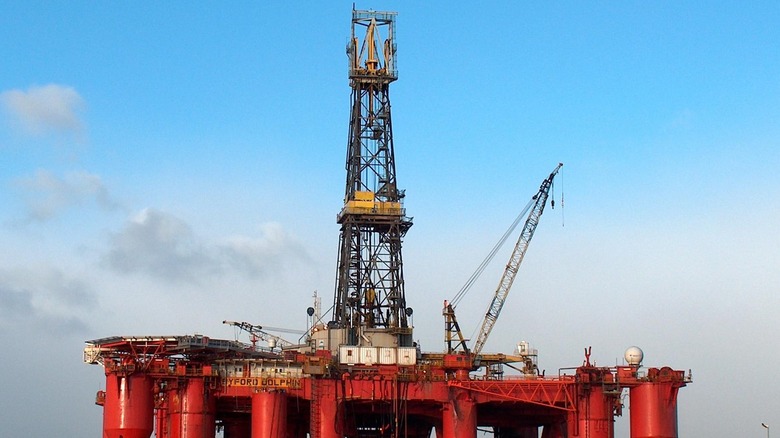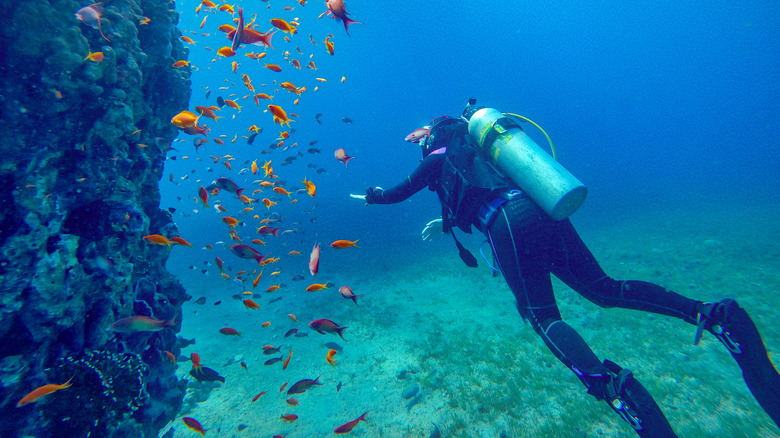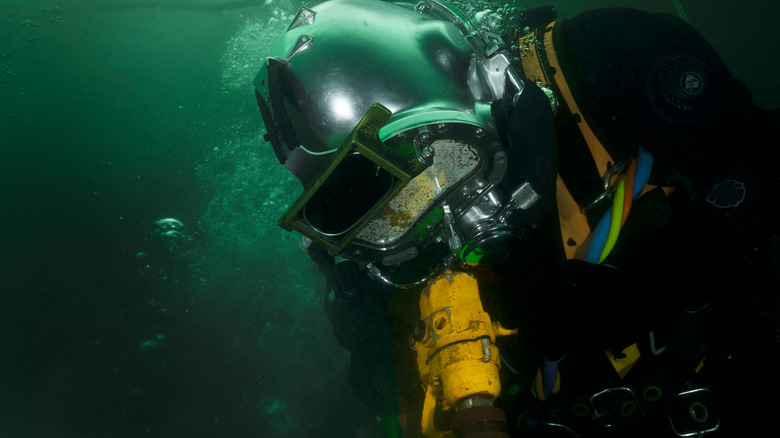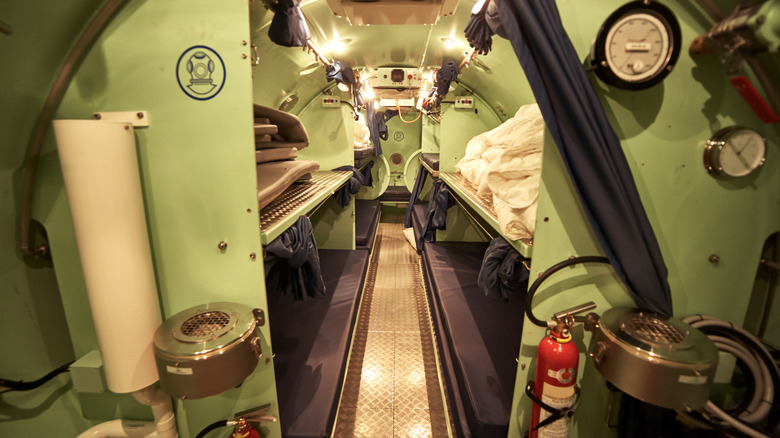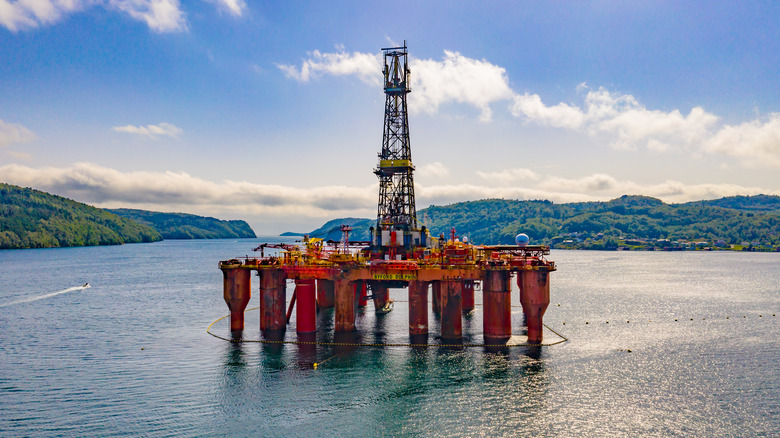The Byford Dolphin Accident: The Explosive Decompression Of 5 Deep Sea Divers
On November 5, 1983, an accident at the Byford Dolphin oil rig, located in the North Sea off the coast of Norway, cost five people their lives in a particularly horrifying way. The incident shocked the public and led to more stringent safety regulations for those diving at inhospitable depths. The event now stands as a cautionary tale for deep-sea divers, who operate at high risk depths.
The rig's owners employed four divers and two assistants called dive tenders to perform underwater maintenance via saturation diving, a very risky operation. An error between the divers' pressurized living space and the unpressurized dock caused an explosive decompression, killing all the divers and one of the tenders. Amazingly, the other dive tender survived but was severely injured. Along with the implosion of the Titan submersible, it's considered one of the most horrifying undersea accidents in history. While the two instances share some similarities, they're actually quite different – one involving compression and the other decompression.
To explain what went wrong, it's vital to understand the dangers of decompression sickness on the human body, saturation diving, and the science behind what happened at the moment of the accident.
The following article includes descriptions of traumatic injury and death. Some images of the Byford Dolphin Accident may be upsetting to view, and SlashGear advises caution if you're searching for related information.
[Featured image by Josef Pavlik via Wikimedia Commons | Cropped and scaled | CC BY-SA 3.0]
What happens to your body when you dive?
Undersea diving attracts countless tourists to spots where they can safely dive at relatively shallow depths, usually 100 feet or less, and for a short time. Professional divers, however, will go much deeper and for longer periods. That's why they need to worry about decompression sickness.
This phenomenon occurs when a diver hits high depths and comes back up too quickly. The process begins with air tanks. They contain the same mix of oxygen and nitrogen as air on the surface or sometimes have added helium. While the body uses the oxygen, the nitrogen builds up and becomes highly pressurized by the undersea environment. The human body normally has some nitrogen, but when diving, this nitrogen is compressed, so the body fills the space with more nitrogen from the air tank.
As divers go deeper underwater, they experience higher degrees of pressure, each measured as one atmosphere's worth of pressure. So 2 atmospheres is double the pressure on Earth's surface, 3 atmospheres is triple, and so on. At 3 atmospheres, a diver's body contains three times the typical amount of nitrogen. If they come up too quickly, the nitrogen will instantly expand to its normal size inside the diver's body and cause pain, difficulty breathing, and in the worst cases, death. That's why divers must slowly come up, a little bit at a time, so the nitrogen can safely expand and decompress.
What is saturation diving?
Decompressing before coming to the water's surface can take hours or even days, especially if diving deeply. Because divers working on a deep sea oil rig might frequently need to go down and come back up at high pressure, they use a method called saturation diving. This involves a living space known as a habitat, which is pressurized to the same level as the water in which the divers work. This way, there's no need to decompress each time the diver comes up, because the gas in their bodies will stay pressurized. Saturation diving is uncommon due to the stress it causes on the body, and divers can only saturation dive for a few weeks at most.
These pressurized facilities have an unpressurized docking area. When the divers leave the habitat, they get into a pressurized diving bell and are lowered into the water by the dive tenders, according to IFLScience. When they're ready to come back, they return to the pressurized diving bell, and the dive tenders at the dock pull it back up.
The divers spend days or weeks under the same, constant pressure. After their sanctioned period comes to a close, they're swapped out with new divers. Saturation diving is dangerous, and the crew must be experts to ensure everyone remains safe.
The Byford Dolphin Accident
On November 5, 1983, two divers, Bjørn Bergersen and Truls Hellevik, were returning from a dive. Fellow divers, Edwin Coward and Roy Lucas, were already inside the habitat. Two diving tenders, William Crammond and Martin Saunders, were operating the diving bell for Bergersen and Hellevik.
The Byford Dolphin habitat was pressurized to 9 atmospheres to match the water in which they worked, according to a YouTube channel called Waterline Stories. This, according to the diver in the video, meant that everyone the habitat had nine times the usual amount of nitrogen in their bodies as they would normally on the surface. As Bergersen and Hellevik were moving from the diving bell to the habitat, the diving bell was accidentally depressurized before Hellevik could fully close the habitat door. The divers went from 9 atmospheres of pressure to 1 instantly. The expanding nitrogen inside their bodies had nowhere to go but out, and that much pressure being suddenly released created an explosion like a bomb.
Three of the divers died when their blood flash-boiled – meaning the expanding nitrogen in their bloodstream turned into air bubbles. It's an effect similar to the bubbles rising in a pot of boiling water. The fourth, Hellevik, was forcibly ejected by the escaping gas through a small opening in the door he was trying to close, mutilating his body and scattering appendages across the dock. Blasted from its position due to the escaping gas, the diving bell crushed the tenders. Martin Saunders amazingly survived, but the other five died instantly. None of them felt anything.
The aftermath
Following the disaster, investigators claimed the improper seal on the diving bell was due to an error made by William Crammond. They alleged that he mistakenly depressurized the diving bell early while it was still connected to the habitat and the doors between were open. However, in 2008, the cause was found to have been an equipment malfunction, absolving Crammond.
The Byford Dolphin oil rig was also using a severely outdated diving system. Construction on the rig finished in 1974, and by 1983 the diving system was already obsolete. Still, the company continued using this older system. Newer regulations might have prevented the disaster if they had been followed.
The incident also led to the formation of the North Sea Divers Alliance, a lobbying group advocating for safer conditions for divers working in the North Sea. The Byford Dolphin oil rig kept running after the tragedy, but due to its owners' financial struggles, it shut down in 2016.
